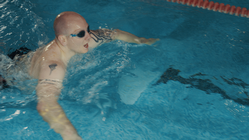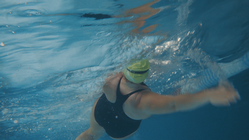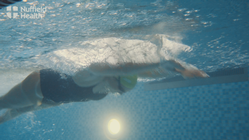Swimming for retirement fitness
- Overview
Benefits of swimming
Swimming is one of the best ways to exercise for many reasons.
It’s a full body workout that requires constant, steady movement, working all of the muscle groups, improving both your cardiovascular fitness and your muscular strength.
Swimming is also a low-impact exercise, so there is far less stress on your joints and therefore less risk of sustaining injury.
Joining an adult swim programme can help get you started and keep you on track with a group of swim sessions over the course of several introductory weeks, ensuring that you are exercising safely in a way that suits you.
You’ll also learn lane etiquette and tips to help you feel confident in the water.
Dipping your toe in the water
Start with a gentle swim routine that allows you to build at a pace that suits you and your fitness level.
For the first three months, aim to swim once a week. You'll soon feel your body adapting to the activity.
As the weeks go by, add in a few more swim sessions if you like, but swimming once-a-week will ensure that you build muscle and develop the stamina to continue. Starting this way will ensure swimming becomes a habit, which is essential if you want to continue and maintain your fitness in retirement.
Don't get discouraged if the swimmer in the next lane is much faster. All that matters is working at a pace that’s right for you.
Strokes
Whether it's breaststroke, freestyle, butterfly or backstroke, lane swimming is one of the best exercises for boosting circulation, muscle tone, lung capacity and losing weight.
Breaststroke is the most popular and is great for casual swimming.
Freestyle (front crawl) is best for speed and, alongside butterfly, which is also a fast stroke, uses the most energy.
Backstroke is good for relieving back pain and as with all strokes it’s a great way to maintain regular exercise that benefits the whole body. Tip: Start out with a stroke that you feel comfortable with and if you’re unsure seek advice from a swim teacher.
Swim workouts can be anything from a number of lengths to a full workout – the aim is to feel you’ve given yourself a good workout and get the blood pumping without feeling uncomfortable and exhausted. Your swimming teacher will help keep you motivated and make sure you’re doing the kind of workout that’s just right for you.
Conclusion
Give swimming a try. There's probably a local pool near you. Regular swimming not only makes you feel good, it can also reduce the risk of chronic illnesses, such as heart disease, type 2 diabetes and stroke. It can also boost your mood and keep your weight under control.
If you’re still not sure about swimming, ask if you can watch a swimming session or two to see if it's for you, or speak to the swim team at your nearest Nuffield Health gym.
Last updated Wednesday 28 August 2019
First published on Tuesday 27 August 2019





